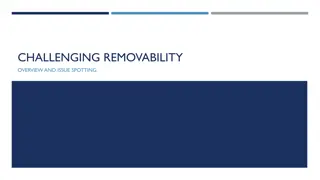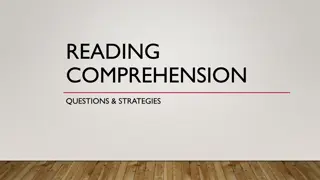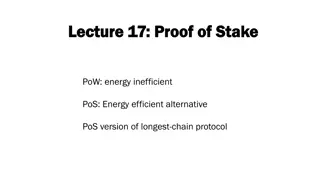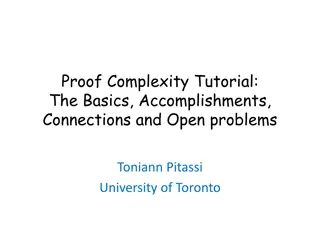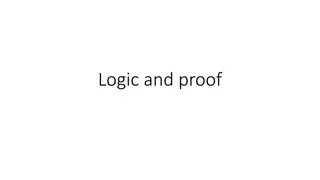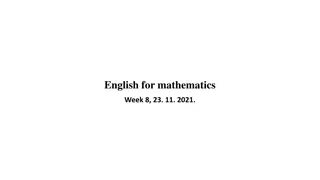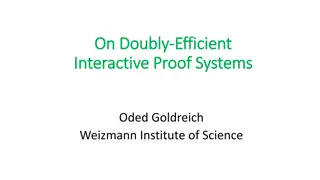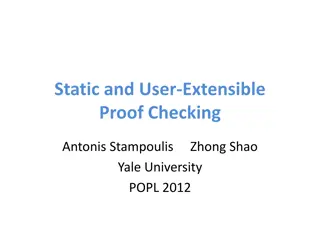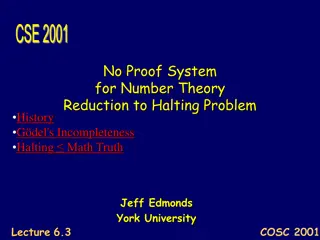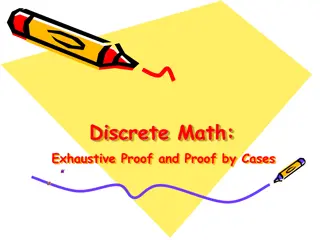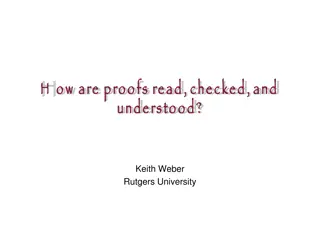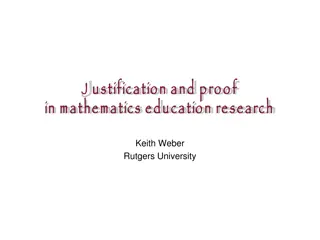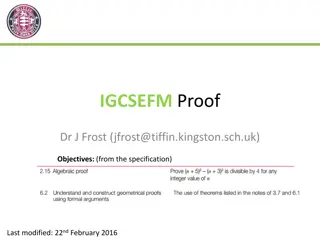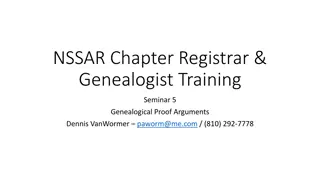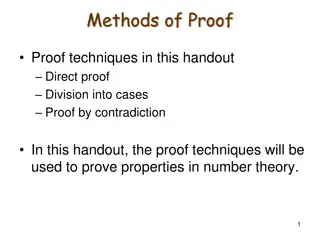Effective Learning Strategies for Mathematical Proof Comprehension
Explore self-explanation training techniques to enhance students' understanding of mathematical proofs. Dive into key concepts such as definitions, worked examples, theorems, and proofs, focusing on intuitive learning methods and practical applications.
Download Presentation

Please find below an Image/Link to download the presentation.
The content on the website is provided AS IS for your information and personal use only. It may not be sold, licensed, or shared on other websites without obtaining consent from the author.If you encounter any issues during the download, it is possible that the publisher has removed the file from their server.
You are allowed to download the files provided on this website for personal or commercial use, subject to the condition that they are used lawfully. All files are the property of their respective owners.
The content on the website is provided AS IS for your information and personal use only. It may not be sold, licensed, or shared on other websites without obtaining consent from the author.
E N D
Presentation Transcript
Friday@2 Studying independently Vicky Neale
An activity A or U Cool Jump Country About Window Match Melt Only Single Yourself Pleasantness Corn Urge Diamond Welcome Aeroplane Fruit Race Winter Disease Holiday
Memory is the residue of thought Daniel Willingham
Definitions Worked examples Theorems (and Propositions and Lemmas and Corollaries) Proofs (sometimes a proof can be a worked example!)
Definitions Do I have an intuitive understanding of the definition? Is there a relevant picture or shorthand? Do I know some standard examples? Do I know some extreme examples? Can I think of some non-examples?
Worked examples Can I go through the example without referring to my notes? What are the key points where I have to make a decision/have an idea? What is it about this example that makes it suitable for this technique? What are the general principles?
Theorems and other results Do I intuitively believe that the result is true? What are the assumptions/conclusions? Are they strong/weak? If I drop a condition, is the result still true? Is there a picture? What does this tell me about my favourite examples? Is the converse true? Can I generalise?
Proofs Where do I use each assumption in the proof? What does the proof like in a special case? Is there a picture? What are the fiddly details?
Proofs We re going to look at self-explanation training , in a mathematical form developed by researchers at Loughborough University self-explanation training has been shown to significantly improve the quality of students reading and their resultant proof comprehension
Proofs We re going to work through an introduction to self-explanation training produced by researchers in Loughborough At the end, there will be paper copies of the booklet, and it will also be available online with the other Friday@2 follow-up material, so that you can revisit it in your own time. The Loughborough material is licensed under a Creative Commons Attribution-ShareAlike 4.0 International License
How to read proofs: the self- explanation strategy The self-explanation strategy has been found to enhance learners problem solving and comprehension across a wide variety of subject domains. It can help you to better understand mathematical proofs: in one recent study students who had worked through these materials before reading a proof scored 30% higher than a control group on a subsequent proof comprehension test.
How to Self-Explain After reading each line: Try to identify and elaborate the main ideas in the proof. Attempt to explain each line in terms of previous ideas. These may be ideas from the information in the proof, examples from previous theorems/proofs, or ideas from your own prior knowledge of the topic area. Consider any questions that arise if new information contradicts your current understanding.
How to Self-Explain Before proceeding to the next line of the proof you should ask yourself the following: Do I understand the ideas used in that line? Do I understand why those ideas have been used? How do those ideas link to other ideas in the proof, other theorems, or prior knowledge that I may have? Does the self-explanation I have generated help to answer the questions that I am asking?
How to Self-Explain We ll look at an example showing possible self- explanations generated by students when trying to understand a proof (the labels (L1) etc indicate line numbers). Please think about the example carefully in order to understand how to use this strategy in your own learning.
Theorem No odd integer can be expressed as the sum of three even integers. Proof (L1) Assume, to the contrary, that there is an odd integer x, such that x = a + b + c, where a, b, and c are even integers. (L2) Then a = 2k, b = 2l, and c = 2p, for some integers k, l, and p. (L3) Thus x = a + b + c = 2k + 2l + 2p = 2(k + l + p). (L4) It follows that x is even; a contradiction. (L5) Thus no odd integer can be expressed as the sum of three even integers.
After reading this proof, one reader made the following self-explanations: This proof uses the technique of proof by contradiction. Since a, b and c are even integers, we have to use the definition of an even integer, which is used in L2. The proof then replaces a, b and c with their respective definitions in the formula for x. The formula for x is then simplified and is shown to satisfy the definition of an even integer also; a contradiction. Therefore, no odd integer can be expressed as the sum of three even integers.
Caution! The self-explanation strategy is not the same as monitoring or paraphrasing. These two methods will not help your learning to the same extent as self-explanation.
Paraphrasing a, b and c have to be positive or negative, even whole numbers. There is no self-explanation in this statement. No additional information is added or linked. The reader merely uses different words to describe what is already represented in the text by the words even integers . You should avoid using such paraphrasing during your own proof comprehension. Paraphrasing will not help your understanding of the text as much as self-explanation.
Monitoring OK, I understand that 2(k + l + p) is an even integer. This statement simply shows the reader s thought process. It is not the same as self- explanation because the student does not relate the sentence to additional information in the text or to prior knowledge.
Avoiding monitoring A possible self-explanation of the same sentence would be: OK, 2(k + l + p) is an even integer because the sum of three integers is an integer and two times an integer is an even integer. In this example the reader identifies and elaborates the main ideas in the text. They use information that has already been presented to understand the logic of the proof.
Your goal You should use the self-explanation approach after reading every line of a proof in order to improve your understanding of the material.
Practice Proof 1 Theorem. There is no smallest positive real number. Proof. Assume, to the contrary, that there exists a smallest positive real number. Therefore, by assumption, there exists a real number r such that for every positive number s, 0 < r s. Consider m = r/2. Clearly, 0 < m < r. This is a contradiction since m is a positive real number that is smaller than r. Thus there is no smallest positive real number.
Practice Proof 2 Definition. An abundant number is a positive integer n whose divisors add up to more than 2n. For example, 12 is abundant because 1 + 2 + 3 + 4 + 6 + 12 > 24.
Practice Proof 2 Theorem. The product of two distinct primes is not abundant. Proof. Let n = p1p2where p1and p2are distinct primes. Assume that 2 p1and 3 p2. The divisors of n are 1, p1, p2and p1p2. Note that (p1+ 1)/(p1 1) is a decreasing function of p1. So max{(p1+ 1)/(p1 1)} = (2 + 1)/(2 1) = 3. Hence (p1+ 1)/(p1 1) p2. So p1+ 1 p1p2 p2. So p1+ 1 + p2 p1p2. So 1 + p1+ p2+ p1p2 2p1p2.
Useful books/websites What will improve a student s memory? Daniel Willingham https://www.aft.org/sites/default/files/periodicals/willingham_0.pdf How to think like a mathematician Kevin Houston (CUP, 2009) How to study for a mathematics degree Lara Alcock (OUP, 2012) https://www.lboro.ac.uk/departments/mec/research/mathematical- cognition/self-ex-training/ (includes one-page summary of relevant research, with links to full papers)
Remember Using the self-explanation strategy has been shown to substantially improve students comprehension of mathematical proofs. Try to use it every time you read a proof in lectures, in your notes or in a book.



